Specifications:
- FE206E Frequency response f0 – 20khz Sound Pressure Level 96db Rated Input 30w
- Music Power 90w Overall Diameter 208mm Baffle Hole Diameter 185mm Depth 87.5mm
- Specifications FE126E
- Frequency response fs – 25Khz
- Sound Pressure Level 93db Rated Input 15w Music Power 45w Overall Diameter 142mm Baffle Hole Diameter 104mm Depth 61mm
I like a bargain.
I am sure that most of you do too. However there is always lurking in the back of our minds “there is no such thing as a free lunch”. One way to accelerate your way up the Hi Fi ladder is to diy it. If you choose the components you intend to make, carefully, you can in most cases end up with something that sounds as good, if not better than similar manufactured units. The main reason to DIY is that you can save yourself a whole bucket load of money.
I have owned many pairs of loudspeakers over the years, but shied away from making my own as I always thought that there was a black art to speaker designing that required specialist test equipment and programs to design crossovers and an anechoic chamber to test them properly. In most cases this is probably true. However there is a way around this. There are a number of manufacturers who make full range single driver units. One in particular, www.fostex.com has a wide range of units at reasonable prices. The drive units require no crossover and are therefore driven direct by the amplifier which is said to cut out any phase anomalies that can result from the use of a crossover.
I spent a couple of months viewing the various forums that carry threads about full range drivers and appropriate cabinets to use. Having been directed to this site (simons site) I decided that if I was going to build a speaker I would build a big ‘un. They say that a good big ‘un, always beats a good little ‘un. I realised that these would weigh a Ton each , but hey nothing ventured, nothing gained!
I opted for the Fostex FE208 Sigma cabinet for the FE206 (specs+cutting plan). The recommended enclosure is what is called a Back Loaded Horn. The horn could be said to be an acoustic impedance transformer. When a diaphragm vibrates, pressure waves are created in front of it. Coupling the motion of the diaphragm to the air is not an easy thing to do due to the different densities of the diaphragm and air. The horn assists the solid-air impedance transformation and creates a higher acoustic impedance for the transducer to work into, thus allowing more power to be transferred to the air.
A horn is a tube which increases exponentially. The narrow end is called the throat and the wide end the mouth. The drive unit is placed at the throat and when the diaphragm moves it is under high pressure, as it moves towards the mouth, the pressure decreases and the amplitude increases, thereby increasing the amplification. A folded or back loaded horn, allows a horn of a much longer length to be compacted to fit into small(er) cabinets. Horns have lower distortion than conventional drivers, faster transient response and are easier to drive to high SPL’s than conventional drivers.
Not only did I have to consider which drive unit and cabinet to go for, but also which material to use to make the cabinets out of. I was told MDF (Medium Density Fibreboard) was not good as it resonates. As MDF is really only compressed wood dust and glue, I was not about to waste my time, and more importantly my hard earned cash! I was told to use Baltic Birch Ply as this is the king of ply woods. I believe I am right in saying that this particular ply uses whole sheets bonded together, not just the outer sheets. Therefore when you cut it, you don’t get gaps.
I managed to source Birch Ply from my local timber yard, who also cut the pieces required to make the cabinets (see plan Fostex 208 Sigma recommended enclosure) the cutting plan is for one speaker only. I was impressed with the quality of the ply, and boy was it heavy compared to MDF. The build up sequence is shown on Simon’s site and so I will not repeat it here. The build took about 6 weeks of evenings and weekends. I finished the cabinets with 4 coats of primer/ undercoat and 4 of black gloss paint. The 206 cabinets graced the cover of March’s A$$A edition.
I then installed them in my listening room. I was pleasantly surprised that as I only have a small room that they did not dominate the room too much. For damping purposes it is suggested that you put some hollowfil material (nylon pillow stuffing) in the chamber behind the drive unit and carpet felt in the chambers in the bottom of the cabinet. After time I found that a large ball of pillow stuffing up the rear fold helped tame some unwanted midrange coming out of the mouth.
They say that you either love or hate horns. Some say that the mid-range shouts at you and that they don’t do really low bass…
I love them. They connect you directly to the music. “Visceral” is a term often used to describe how something grabs you by the lapels and makes you take notice. When you crank the volume you really get that sense of being there. On the other hand they do delicate and simple acoustic music and vocals really well.
Subwoofers come in for a lot of criticism. I feel that used sparingly they are a definite aid to good sound. Horns and a Sub ??!!! are you crazy!
I am not really into home cinema, although a few years ago I picked up a cheap Cambridge V500 surround sound processor which is just Dolby Digital 5.1. I ditched the centre and surround speakers some time ago and so it runs in stereo with a dedicated subwoofer feed.
I have a fantastic Don Henley DVD . The dedicated subwoofer feed really comes into its own. I set the main stereo speakers to “small”, yea I know, strange that you would designate “small” to the behemoth 206s, but if you don’t, this little processor don’t give you no bass!
“All she wants to do is dance” is one of my favourite tracks. The percussion and bass line driving the track along to superb effect. How does Don Henley continue to sound so great after all these years? Without the subwoofer the track sounds anaemic. With it, it makes for the “being there” experience. Something that never fails to bring a grin to my face is that the camera work shows the crowd (at some points) from the back of the auditorium. During “all she wants to do is dance” you see this guy who is either so engrossed in the performance or a real rhythm klutz, with his hands in the air clapping hopelessly out of time.
I could go into minute detail about how each of my favourite tracks sound, but I will cut to the chase and use these terms to describe what I found: A liveness, attack, ballsy, with depth and effortlessly musical.
I was advised that the 206’s need at least 200 hours burn-in to sound even half decent, then they continue to improve over the following months and years. Mine have been used since November 06 and so I reckon I have easily passed the 200 hours now. What also contributes to the “mellowing” process is the ageing and patination of the Banana fiber/paper cone material. This is in a way the same process as the cabinets maturing. I could hear over a number of months the cabinets drying out and hardening up and everything starting to gel together. Good wood furniture matures once it is installed in your home. Heat and humidity play a vital role in this process. The 206’s are getting better with age.
I tended to agree with some people’s findings that the midrange could shout a bit and Dave Dlugos of Planet 10 Hi Fi www.planet10.com make phase plugs to fit in the void of the voice coil to cure this. I ordered some phase plus shortly after I finished the cabinets. However to fit them it is necessary to perform surgery on the drive units and cut the cone where it covers the void. I put off doing this for some months as I was not about to destroy the beautiful (if slightly flawed) sound and many weeks of hard work. I looked around for an alternative.
I found www.humblehomemdehifi.com . The guy whose site this is had used some lateral thinking and come up with a way of “curing” the shout without resorting to surgery. Basically he used some wire and fashioned a frame on which to attach some light bulbs of varying shapes a sizes which he secured in place just off the whizzer cone. I made some similar devices out of some small lampshades and secured them in place. If you look carefully at March’s cover you can see them over the Fostex cones. I could see why he had bothered. The shout was lessened and the sweet spot enlarged. If you sat off-axis, you could still hear what was going on. I left these in place for 2or 3 months before I plucked up the courage to perform the surgery required to fit the pukka phase plugs. I have added this procedure as an up-date.
Is it worth making your own speakers? The cost of the 206E’s is £80 ($160) in the U.K per drive unit. The cost of the Birch Ply will differ from supplier to supplier, but is more expensive than MDF. There is a certain satisfaction with making something yourself. As the cabinet has been designed by Fostex all the guesswork is taken out and you know the result of your labours will be that it will sound good. The cabinet I chose is in fact designed for the 208 Sigma drive unit. However, my extensive research informed me that this cabinet worked better with the 206 than the dedicated 206 cabinet which I was told had bass suckout higher up the bass region. Others had built the 208/206 to great effect, so that was the one for me. The combination makes for a great communicator and music maker. I suspect that it is colored in the mid-range and probably not totally accurate, but if you want to be totally blown away as you have your 4th glass of wine/pint of beer or whatever your preference is on a Saturday afternoon/ evening, when the volume knob gets tweaked ever nearer that magic 12oclock position ! But don’t leave the room and come back in and then start the next track, Whoaaa, who turned that up ! Crikey they will be able to hear that in London. For you yanks London is a little village with a few hundred inhabitants about 40 miles from me.
Live Drums
You cannot beat the sound of live drums. There is a teenager who lives across the road from us who started learning the drums when we moved to this house six years ago. His parents obviously threaten him with physical violence as the “sessions” are confined to before 7pm and last about an hour. Over the years I have been mightily impressed with how he has come on and his skill level is now, in my humble opinion, excellent.
Stanley Clarke is a bass player par excellence. East River Drive (Epic 4737972) is a CD from 1993. “Funk is it’s own reward” is the final track on this superb album. Dennis Chambers on drums does a blinding performance. Horn bass is very dynamic and tactile, you can feel the sticks hitting the skins, the bass drum pounding away. In my listening room you can feel it kick you in the back (when you’re getting to the 4th glass of wine!) “Funk is it’s own reward” is funk with a capital “F”. Some guys know instinctively how to do funk, namely George Duke, Marcus Miller, Jeff Lorber and many others. This track grabs hold of you from the first few bars and doesn’t let go until the end, the drums and the bass powering the track along like a steam train, the track builds until the finale, and believe me by the end of the track you are really out of breath. Dennis Chambers and Stanley Clarke literally doin’ it to death. It takes a special synergy to create something so tight and dynamic. If you’re system can’t handle it, then the experience will be totally lost. As you will know I use a modified Sonic Impact amplifier, 4-5 watts into 8ohms. The dynamics this little wonder can create with the 206 horns is way way above anything you would have expected. They seem to be made for each other.
Everything but the Girl : Greatest Hits, Blanco Y Negro 5426162 Tracey Thorn and Ben Watt made up EBTG. They produced a number or very good albums in the late 80’s early 90’s. They then turned their hand to producing a “drum and bass” themed album (name it). I don’t know if “drum & bass” and “jungle” had the same sort of following in the states as here in the U.K. Drum and bass and jungle had a following with the 146db in-car modders scene. If you were walking down the road and the tarmac was vibrating, but you couldn’t hear anything else you could be pretty sure that a modded rust bucket with ICE worth 100 times more than the car was idling around the corner.
I would say that EBTG made drum & bass respectable and injected intelligence into an otherwise “underclass” genre. The tracks were very clever and fused melodies and sensible lyrics with the drum & bass rhythm patterns. Walking Wounded and Before Today typifies the EBTG drum & bass sound.
So, I think you might have guessed that I am totally smitten with the 206/208’s. I decided I would see what a smaller Fostex drive unit would sound like. Again, research and meanness led me to the 126E 4” drive unit. The cabinet I chose to build was intended for the 108sigma. However, as it is a scaled down 208, which I thought would be a piece of cake.
Fostex 126E/108 Sigma Cabinet
I regularly attend what are called here in the U.K Audiojumbles. Places where you can buy old (or very old) hi fi, valves, speakers, speaker drive units, turntables, CD players, cables, capacitors etc., etc, basically anything to do with sound or electronics to make sound.
I attended one in February 07. There was a guy there who had got hold of a lot of “b” grade Rega loudspeaker cabinets. To cut a long story short, I got hold or several pairs for myself and others at a bargain price. For the 126E I decided that the Rega R7 cabinet was near enough size wise to tweak the internals and make the small horn cabinet. If any of you are familiar with the Gemme Audio Concerti 108, it uses the same design, but the 108 sigma drive unit. They smooth off all the internal components, give them many coats of lacquer, bake them for hours to get them rock hard and charge $3,400 per pair!! The R7 cabs cost me £25 ($50) and the 126E’s are £80 ($160) per pair. The R7s are quite a good looking cabinet being tall and slim and having good quality Beech veneer. All that was about to change as I set to work destroying them. I had to cut one side off each cabinet, fill the hole where a dedicated side-firing bass unit would have gone and fit the internal horn woodwork.
When I made the 208 cabs I had all the lovely Birch ply cut professionally, each piece cut mostly to the right size. So it was really like a jigsaw puzzle, just gluing the pieces in place. For this project I would be cutting all the bits myself from whatever I could find, old bits of left over ply, MDF, Chipboard etc. As a result I made it much harder for myself and the build took longer than I anticipated (see pictures Internal and Clamped) not a pretty sight really !
As I neared the finish of the first cabinet I started to have doubts about what I was doing, you know how sometimes you think to yourself “why on earth did I get into this?”, but I ploughed on and made the second and so I had a pair. What had given me some encouragement was after the first cabinet was finished I stuck an old mid-range driver in it to see what it would sound like. I was gob-smacked, that much bass from a 2.5inch mid-range (see picture Clamped).
So, I filled all the holes where I had “glued & screwed” the cabinets together, sanded and painted them and you can see the end result. After having installed the drive units I wired them up and switched on. My initial reaction was they had the same sonic signature as the larger 206s, but as they were not yet run in, more high frequency information and less bass. It is inevitable that they would produce less bass, after all they have an effective cone area of 2.5 inches. The fact that they produce any bass at all is remarkable.
They produce an extremely wide sound stage, similar to the 206s. Having set the 126’s up in my listening in order that I could evaluate them with my regular equipment, it was not possible to position them where I would have liked them as the 206’s occupy that position. (see picture 206 +126) There is no way that the 206’s will be leaving the room, not even for a short while! So the
lack of bass is probably because they were positioned too far into the room. I suspect the optimum position would be in the corner of a room. Rooms are difficult creatures to understand and so what works for one, doesn’t necessarily work for another. However, over the time it has taken me to write this review the speaker is loosening up and I seem to be getting more bass.
I used some tried and tested tracks to evaluate them from Steely Dan, Donald Fagen, Jennifer Warnes, and to test their low end capability, shock, horror! Some Nu Jazz compilations, you know the stuff where they sample the smallest part of a well known jazz track and then proceed to annihilate it with processed bass and drums at about 120bpm. But… I must confess that some of it is very well done and I like it for a change, I also tried some “Ibiza” style chill-out stuff, in much the same vein. It was interesting that the lack of full bodied bass was a positive with these tracks. Mostly they are produced for boom boxes, so any hike in the bass is usually welcome. In a full frequency system, the bass can over dominate and drown everything else.
The 126’s are a great speaker if you are after the “Horn” sound on a budget or if you do not have room for larger versions or the WAF (Wife Acceptance Factor) is the main criteria. I think if I had built the 126’s first I might have been disappointed. There is bass, and it is getting better as I move towards the magic 200 hour mark (less than 30 so far). The clarity is fantastic and vocals are really well defined and lifelike. On a lot of the music I listen to I would have to use a subwoofer. I think I am a bit of a basshead, because if I know there is a bass line on a particular track and I can’t hear it (or feel it!) then I am not a happy listener. Having been spoilt with the 206’s, anything else will probably always come second. I will up-date you in a few months time when I have put more miles on the clock. 206 horns is way way above anything you would have expected. They seem
to be made for each other.
Everything but the Girl : Greatest Hits, Blanco Y Negro 5426162 Tracey Thorn and Ben Watt made up EBTG. They produced a number or very good albums in the late 80’s early 90’s. They then turned their hand to producing a “drum and bass” themed album (name it). I don’t know if “drum & bass” and “jungle” had the same sort of following in the states as here in the U.K. Drum and bass and jungle had a following with the 146db in-car modders scene. If you were walking down the road and the tarmac was vibrating, but you couldn’t hear anything else you could be pretty sure that a modded rust bucket with ICE worth 100 times more than the car was idling around the corner. I would say that EBTG made drum & bass respectable and injected intelligence into an otherwise “underclass” genre. The tracks were very clever and fused melodies and sensible lyrics with the drum & bass rhythm patterns. Walking Wounded and Before Today typifies the EBTG drum & bass sound. So, I think you might have guessed that I am totally smitten with the 206/208’s. I decided I would see what a smaller Fostex drive unit would sound like. Again, research and meanness led me to the 126E 4” drive unit. The cabinet I chose to build was intended for the 108sigma. However,
as it is a scaled down 208, which I thought would be a piece of cake.
206 Phase plugs update
You will see from the picture of the 206/126’s that they now sport a black phase plug. I obtained these from Dave Dlugos at www.planet10.com. Once I plucked up the courage to cut my beloved cones to pieces, the process took very little time at all. The process is described in detail on the website.
The effect of adding the phase plugs is not subtle. It opens them up and widens the soundstage. The treble is improved and they sound much more refined. All the detail I heard before was there, but much more sophisticated and “grown up”. The stock 206 is a great communicator, if perhaps a little on the uncouth side, like a teenager who needs a little taming. The phase plugs add just about the right amount of discipline to keep the 206 from straying from the straight and narrow. Once I plucked up the courage to cut my beloved cones to pieces, the process took very little time at all. The process is described in detail on the website. I decided to experiment with making my own phase plugs and I after having used a light bulb as a stop-gap before fitting the proper plugs I fashioned a “Beauhorn” style plug as can be seen in the picture. They work really well, but add something a little different to the sound. The jury is still out as to whether they are good or not !
Review Equipment
- Cambridge 640Cv2
- LiTe Dac AH
- Ming Da MC7R Tube Pre Modified Sonic Impact amp World Designs Kel 84 Tube amp
 from affordableaudio, By Robert Powell
from affordableaudio, By Robert Powell

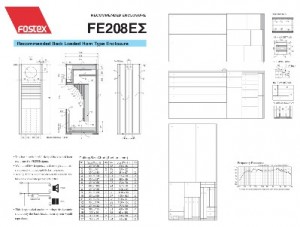
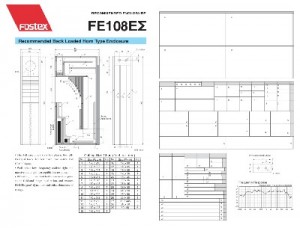
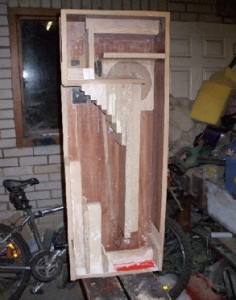
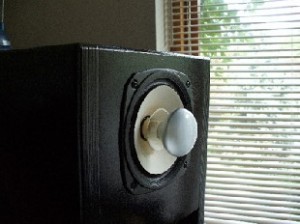
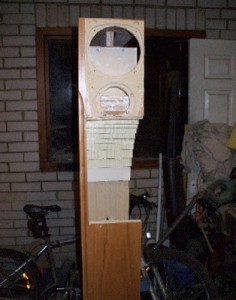
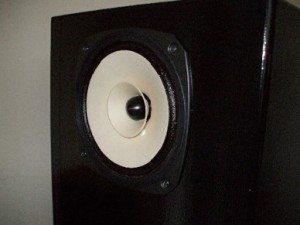
Hi,
Nice BLH there. I am planning to go for FE208 enclosure for my fe206 drivers.
Jericho Horn seems to complex due to its angled edges.
Can you please share the build sequence and finer points to consider while building the FE208 enclosure.
It would be very helpful.
Thanks much.
regards,
Prateek